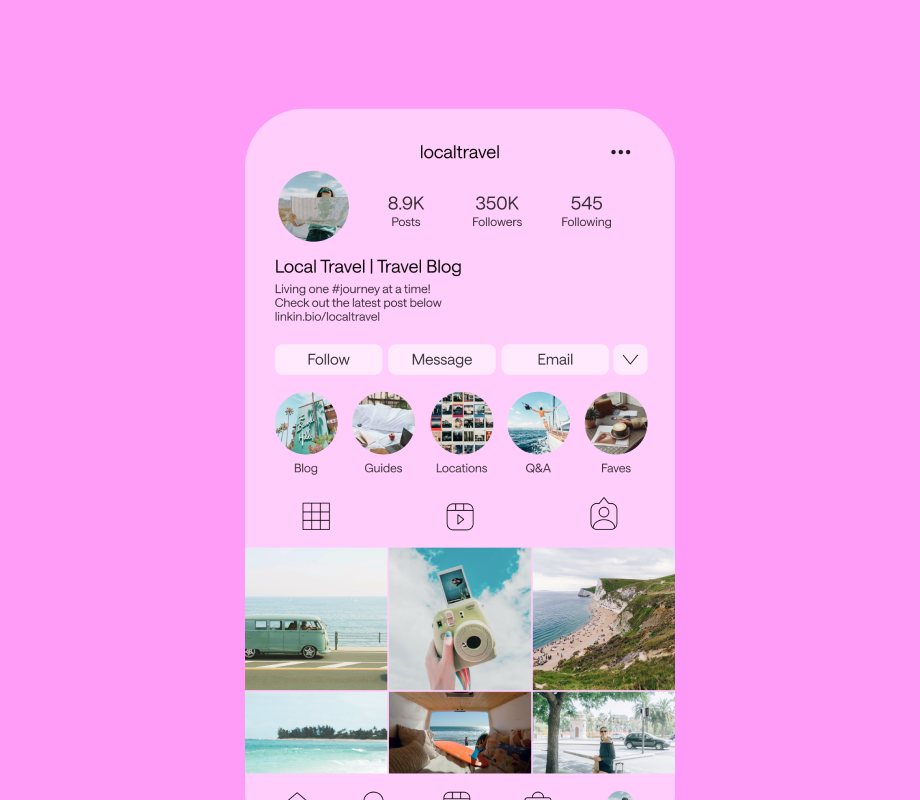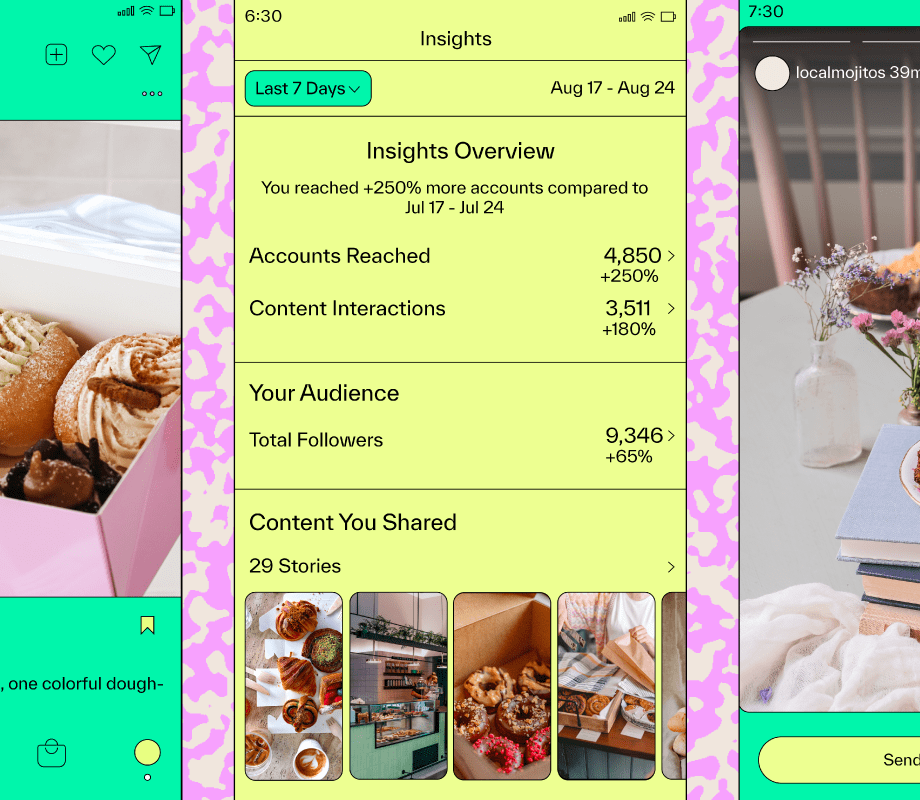Content batching is one of the most effective ways to create social media content your audience loves.
Why? It helps you save time, post consistently, and repurpose your ideas seamlessly across platforms.
In this guide, we’re breaking down eight ways to batch content for social media and ditch the overwhelm. Let’s dive in!
What Is Content Batching?
Content batching is a productivity technique where you create all of your captions or visual content during a set period of time.
For example, instead of spending an hour planning, creating, and publishing one Instagram post, you’ll spend that hour writing or “batching” an entire week of captions.
While this may sound like more work, it’s actually the opposite.
With content batching, you’re able to focus your creative energy without jumping from task to task, and can plan content weeks in advance — creating a more cohesive (and stress-free) approach to your social media strategy.
Ready to plan and schedule your social media posts? Later makes it easy — create an account today:
How To Batch Content For Social Media
Ready to start content batching? With these 8 tips you’ll be able to batch content for social media in no time:
Identify Your Content Pillars
Analyze Your Posts
Brainstorm New Content Ideas
Write Your Captions for a Month
Source Your Photos
Film Video Content
Design Your Graphics
Schedule Your Content Calendar
Content Batching Step #1: Identify Your Content Pillars
Before you start batching content, you need to identify your content pillars.
Content pillars are 3-5 topics you’ll consistently discuss and create content for on social media.
We suggest writing down pillars that reflect your brand along with identifying the themes your audience is most interested in.
Take Girlfriend Collective for example. Their content pillars include sustainability, inclusivity, and everyday wear, and their social media posts consistently reflect these themes:
This creates a cohesive message throughout their social media channels, and their community will always know what type of content to expect.
These topics or content pillars will help you when creating content for social media — think of them as a guide to help you avoid last-minute posts.
Content Batching Step #2: Analyze Your Posts
The next step in the content batching process is to analyze the performance of previous posts and videos.
Reviewing your analytics gives you insight into the type of content your audience engages with most.
You can also ask yourself these questions:
When was the content published? Was it at the most optimal time to post?
What was the call-to-action (CTA) in the caption?
What format did you use? Was it a video, graphic, or lifestyle photo?
Once you have an idea of what worked well (and what didn’t) you can create more high-performing content.
For example, Amanda Kohal from The Wolfe Co frequently shares educational carousel posts which receive lots of comments:
When content batching in the future, Amanda can create carousel posts in a similar format.
Your analytics can also help you pinpoint key takeaways or ideas to repurpose.
If you posted a YouTube video about social media tips that got a lot of engagement, you could film an Instagram Reel a few weeks later leveraging that content.
Repurposing the same content into different formats saves time and ensures your audience interacts with your best content ideas.
By noting what got the most saves, views, clicks, and comments, you’ll be able to decide what type of content to batch for optimal results.
Grow your business, increase engagement, drive traffic, and more with Later’s Analytics — get started today:
Content Batching Step #3: Brainstorm New Content Ideas
After establishing your content pillars and analyzing your best performing social media posts, it’s time to brainstorm content ideas.
First, you’ll want to note any important dates including holidays, launches, and campaigns to ensure your content is relevant each week.
Next, you can review frequently asked questions from your community, timely news, or announcements related to your niche.
Then, start brain dumping any additional ideas like content to repurpose or new trends to test.
And don’t forget to reference your content pillars during your brainstorming session. They’ll help keep you on track so you don ’t stray too far from your core topics.
Content Batching Step #4: Write Your Captions for a Month
Now that you know the type of content you’ve planned, it’s time to start writing captions!
Use this formula to help write engaging social media posts:
Hook: This is the first line in your caption that will draw your audience in and stop their scroll. Use wording that will compel them to read more.
Line Breaks: Avoid cluttered captions by using line breaks. It will also help make long captions easy to read and skim.
Emojis: Depending on your brand voice, emojis can add personality, color, and emotion to your caption — making it more interesting to users.
CTA: Boost your post engagement by inviting your audience to take action. You could ask them to comment their thoughts, save the post for later, click on the link in your bio, or shop through your profile.
If you’re content batching captions for multiple social media platforms, start with one caption for your primary platform and reformat the caption for each channel when scheduling.
Take a look at how Jess Ekstrom used a short caption for Twitter and then used the tweet with a longer caption for Instagram:

FYI: Later has a Saved Captions feature where you can easily add your branded hashtags, commonly used CTAs, or captions you’ve saved from previous brainstorming sessions!
Content Batching Step #5: Source Your Photos
After batching your post captions, it’s time to find complementary images for them.
One way is with user-generated content (UGC). With UGC you can repost your community’s photos and videos to your social channels.
Wellness brand Golde frequently shares UGC, letting us see real-life customers use their products:
This is a great way to add authenticity to your social media content and build trust with your audience.
You can also use photos from a photoshoot — either taken professionally or done at home.
Don’t have a fancy camera? No problem. Photos taken on your phone can create a personable feel and there are so many trendy photo editing trends to help elevate your feed’s aesthetic:
And if you don’t have time for a photoshoot, using high-quality stock photography is a great way to go.
ICYMI: With Later, you can plan, schedule, and publish your social media posts in advance for free — sign up today.
Content Batching Step #6: Film & Edit Videos
Don’t forget to incorporate videos into your social media content when batching!
With many social media platforms pushing video content (like Instagram Reels), this is a great way to switch up your visuals and connect with your audience.
When promoting her new mesh brami, Natalie Rogers shared a video via TikTok and Instagram Reels rather than a standard product photo:
If you’re filming videos for your brand, set aside a portion of your day to batch record your footage. This allows you to get camera-ready, set up any props or sets, and capture B-roll.
And most importantly: remember to outline or script your videos. This will help when editing and writing video descriptions and titles.
TIP: You don’t need to hire a professional videographer to create engaging video content. Get our favorite mobile video apps here.
Content Batching Step #7: Design Your Graphics
Graphics can include video cover photos for Reels, carousel infographics, quotes, and Instagram Story slides.
When it comes to content batching, design templates for your most commonly used graphics to make the process quicker.
These templates will create a plug-and-play design that won’t require you to design from scratch each time you batch content.
TIP: Keep video and photo dimensions and sizes in mind when creating your designs. Use this guide as a handy reference!
Content Batching Step #8: Schedule Your Content Calendar
Once you’ve finished brainstorming, writing captions, sourcing photos, and filming videos, you can start planning your content calendar — which will help you organize your library of ideas and important dates.
And with a social media management tool like Later, you’ll be able to see all of your content in one place. You can even choose weekly or monthly calendar views to help keep you organized:
Scheduling your content in advance is a game-changer and an important step in the content batching process.
When you organize your social media calendar weeks (or a month) in advance, it helps you stay ahead of your posting schedule.
This way, you’re not scrambling to post in the moment, creating captions on-the-fly, and becoming overwhelmed.
How to Save Time Batching Content for Social Media
To best optimize your time, follow these productivity tips on your next content batching day:
Set a recurring date and time for your batching sessions. By regularly prioritizing them in your calendar, you can always stay ahead with your planning.
Break up each of the batching steps to ease into a creative flow. The creative energy you’ll use to film a video is completely different than writing a caption. This is why we prefer dedicated time slots to focus on one content batching task at a time.
Start off small when content batching. Slowly batch more content each week until you’re ahead. You’ll be scheduling weeks in advance in no time.
While these content batching tips may feel overwhelming at first, we promise it’s easier than it looks!
When you batch content for social media, you’re able to save time, plan more effectively, and create more content your audience loves.
Ready to put your new content batching strategy to work? Create a Later account and start visually planning and scheduling your content!




